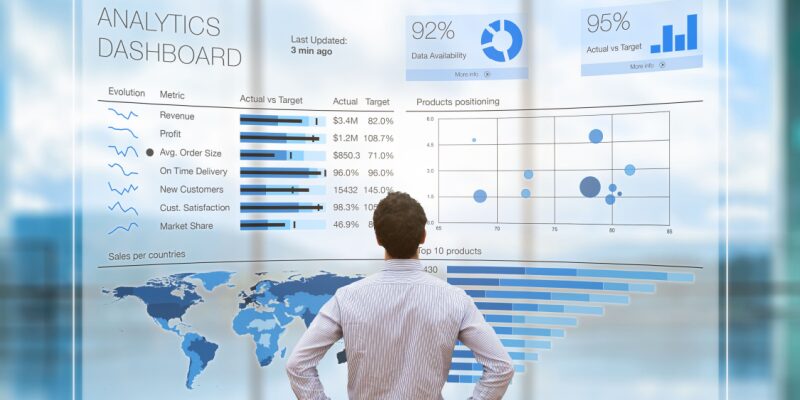In today's data-driven world, organizations are constantly seeking ways to harness the power of data to make informed decisions. At the heart of this transformation lies Power BI, a robust business analytics tool that empowers businesses to visualize and analyze data for better insights. At Andrew Geoffrey, we take this a step further by specializing in tailoring Power BI analytics to not only capture raw data but to transform it into meaningful visualizations that align seamlessly with the cultural identity of an organization.
Understanding the Significance of Cultural Identity:
Cultural identity plays a crucial role in shaping an organization's values, beliefs, and practices. It serves as the foundation that unites a diverse workforce and creates a unique organizational identity. When it comes to data analytics, it's not just about numbers; it's about telling a story that resonates with the essence of the organization's culture. This is where our tailored Power BI analytics come into play.
Capturing Raw Data:
We start by capturing raw data from various sources within the organization. This could include sales figures, customer feedback, employee performance metrics, and more. The goal is to collect a comprehensive set of data that accurately represents the organization's operations.
Transforming Data into Meaningful Visualizations:
The real magic happens when we transform this raw data into meaningful visualizations. Our team of skilled data analysts and visualization experts utilize the power of Power BI to create engaging charts, graphs, and dashboards. But what sets us apart is our commitment to aligning these visualizations with the cultural identity of the organization.
Aligning with Cultural Identity:
Every organization has a unique cultural identity that sets it apart. Whether it's a commitment to innovation, a focus on inclusivity, or a dedication to sustainability – we ensure that our Power BI visualizations reflect these core values. This alignment not only makes the data more relatable but also reinforces the organization's cultural narrative.
- Customized Visual Elements:
- Branding and Colors: Incorporating the organization's colors, logo, and visual branding elements into Power BI reports creates a sense of familiarity. This customization not only reinforces brand identity but also establishes a visual connection between the data and the organization's culture.
- Thematic Design: Adopting thematic design elements that reflect the cultural identity helps in creating a cohesive visual language throughout the analytics. Whether it's through specific imagery, icons, or fonts, these design choices contribute to a consistent cultural narrative.
- Incorporating Cultural Values:
- Metrics Aligned with Values: Tailoring Power BI analytics involves selecting metrics and KPIs that align with the core values of the organization. For instance, if innovation is a key value, the analytics may highlight metrics related to product development, research, or creative initiatives.
- Cultural Narratives:Weaving cultural narratives into the data storytelling process ensures that the insights derived from Power BI align with the overarching cultural identity. This may involve framing data discussions in a way that reflects the organization's mission, vision, and values.
- User-Centric Approach:
- Persona-Based Dashboards: Understanding the diverse roles within an organization allows for the creation of persona-based dashboards. These dashboards are tailored to the specific needs and perspectives of different user groups, ensuring that each user sees data in a way that resonates with their role and responsibilities.
- Personalization Options: Providing users with options for personalization, such as customizable dashboards or interactive features, empowers individuals to engage with the data in a manner that aligns with their preferences and work style.
- Cultural Sensitivity in Data Representation:
- Avoiding Stereotypes: When using visual elements or representations related to cultural aspects, it's crucial to avoid stereotypes and ensure cultural sensitivity. This involves a nuanced understanding of the organization's culture and a respectful approach to visual storytelling.
- Language Considerations: Adapting language and terminology in Power BI reports to align with the cultural context ensures that communication is clear and resonates with the audience. This includes translating labels, titles, and descriptions into language that reflects the organization's cultural nuances.
- Feedback and Iteration:
- Continuous Stakeholder Engagement: Actively seeking feedback from stakeholders throughout the development process is essential. This iterative approach ensures that the tailored Power BI analytics evolve in response to changing organizational dynamics and cultural shifts.
- Agile Development Practices: Adopting agile development practices allows for quick adjustments and refinements based on ongoing feedback. This agility ensures that the Power BI analytics remain aligned with the evolving cultural identity of the organization.
Benefits of Tailored Power BI Analytics:
- Enhanced Understanding:
- Accessible Insights: Tailoring Power BI analytics involves creating visualizations that are easy to comprehend. Complex data is translated into intuitive charts, graphs, and dashboards, making it accessible to a broader audience, including non-technical stakeholders.
- User-Friendly Interface: Our focus on cultural alignment extends to the design of the user interface. We ensure that the visualizations are not only informative but also presented in a user-friendly manner, promoting a seamless and enjoyable user experience.
- Improved Decision-Making:
- Informed Choices: Visualizations aligned with the cultural identity of the organization enable decision-makers to make more informed choices. By presenting data in a context that resonates with the organization's values, leaders can confidently make decisions that are consistent with the overall mission and vision.
- Quick Recognition of Patterns: Tailored visualizations help decision-makers quickly recognize patterns and trends within the data. This accelerates the decision-making process and allows for timely responses to changing circumstances.
- Cultural Integration:
- Reinforcing Core Values: The visualizations serve as a powerful tool for reinforcing and communicating the core values of the organization. When employees see data presented in a way that reflects the cultural identity, it strengthens their connection to the organization's mission and values.
- Fostering a Unified Culture: By integrating cultural elements into data analytics, we contribute to fostering a unified organizational culture. This cultural cohesion is vital for employee engagement, collaboration, and a shared sense of purpose.
- Increased Engagement:
- Interactive Visualizations: Our tailored Power BI analytics often include interactive features, allowing users to engage with the data on a deeper level. This interactive aspect not only enhances user engagement but also encourages exploration and discovery within the data.
- Storytelling through Data: Visualizations tell a compelling story. By aligning this narrative with the cultural identity, we create a more engaging and relatable experience. This storytelling approach captivates audiences and encourages a deeper understanding of the insights presented.
- Strategic Alignment:
- Aligning with Organizational Goals: Tailored Power BI analytics ensure that the insights derived from data align with the strategic goals of the organization. This strategic alignment ensures that analytics efforts contribute directly to the achievement of broader objectives, enhancing overall organizational performance.
In summary, aligning Power BI with cultural identity involves a holistic approach that encompasses visual customization, incorporation of cultural values, a user-centric perspective, cultural sensitivity in data representation, and a commitment to continuous feedback and iteration. This alignment not only enhances the effectiveness of data analytics but also contributes to a stronger sense of cultural integration within the organization.






